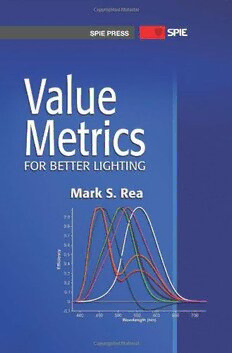Table Of ContentSPIE PRESS
Lighting Research Center
We often do not fully understand what lighting can do for us. We know that we
need lighting, but often that is as far as the thinking goes. We do a really good
job, however, of conceptualizing the costs of those lighting systems because
we can readily measure those costs. Reducing costs will certainly increase the
value ratio for lighting if the benefits of the lighting system are held constant.
Without a clear purpose for the lighting system, and no clear idea of benefits,
there is little else that can be used in the value engineering process. This book
is dedicated to the notion that our society undervalues light because we do not
properly measure the benefits of light, in terms of both the lighting system and
how it is applied. Consequently, we unnecessarily waste our natural and capital
resources. The problems associated with inadequate light measurement
systems are not hard to grasp or even to fix, and are the subject of Value
Metrics for Better Lighting. This book was written as a starting point for
thoughtful consideration, discussion, and action by those vested in better and
more sustainable lighting, including manufacturers, practitioners, regulators,
advocates, educators, and, of course, users.
P.O. Box 10
Bellingham, WA 98227-0010
ISBN: 9780819493224
SPIE Vol. No.: PM228
Bellingham, Washington USA
LibraryofCongressCataloging-in-PublicationData
Rea,MarkStanley,1950-
Valuemetricsforbetterlighting/MarkS.Rea.
pagescm
Includesbibliographicalreferencesandindex.
ISBN978-0-8194-9322-4
1.Lighting.2.Electriclighting–Energyconsumption.3.Lighting,
Architecturalanddecorative.I.Title.
TH7703.R282013
621.32–dc23
2012037160
Publishedby
SPIE
P.O.Box10
Bellingham,Washington98227-0010USA
Phone:+1360.676.3290
Fax:+1360.647.1445
Email:[email protected]
Web:http://spie.org
Copyright (cid:13)c 2013 Society of Photo-Optical Instrumentation Engineers
(SPIE)
All rights reserved. No part of this publication may be reproduced or
distributed in any form or by any means without written permission of
thepublisher.
Thecontentofthisbookreflectstheworkandthoughtoftheauthor(s).
Every effort has been made to publish reliable and accurate information
herein,butthepublisherisnotresponsibleforthevalidityoftheinforma-
tionorforanyoutcomesresultingfromreliancethereon.
PrintedintheUnitedStatesofAmerica.
Firstprinting
Contents
Acknowledgments.....................................................................................vii
Chapter1 Introduction........................................................................... 1
Chapter2 MeasurementMatters............................................................. 5
2.1 WhatIsLight?.................................................................................................. 5
2.1.1 Thephotopicluminousefficiencyfunction................................... 7
2.1.2 WheredoesV(λ)applyandwheredoesn’tit?........................... 11
2.2 WhatIsColor?................................................................................................. 12
2.2.1 Colorappearance.............................................................................. 13
2.2.2 Colormatching................................................................................... 14
2.2.3 Colorimetry......................................................................................... 15
2.2.4 Colorrenderingandtintofillumination......................................... 17
2.3 ColorRenderingIndex................................................................................... 17
2.4 CorrelatedColorTemperature...................................................................... 18
Chapter3 AddedValuefromNewMetrics................................................ 19
3.1 Beyondlm/Wandlm/m2................................................................................ 19
3.1.1 Mesopicvision................................................................................... 21
3.1.2 Apparentbrightness.......................................................................... 23
3.2 Beyond“Light”.................................................................................................. 28
3.2.1 Circadianlight.................................................................................... 29
3.3 BeyondCRIandCCT.................................................................................... 36
3.3.1 Colorrendering.................................................................................. 37
3.3.2 Tintofillumination............................................................................. 40
3.4 LightingEnergyEfficiency............................................................................. 42
3.4.1 Applicationefficacyinthetemporaldomain................................ 43
3.4.2 Applicationefficacyinthespatialdomain.................................... 45
3.4.3 Calculatinglightingenergyefficiency........................................... 48
Chapter4 AnInvitation.......................................................................... 51
4.1 UnifiedIlluminance......................................................................................... 54
v
vi Contents
4.2 BrightIlluminance........................................................................................... 58
4.3 CircadianIlluminance..................................................................................... 60
4.4 “ClassA”Color................................................................................................. 62
4.5 LightingEnergyEfficiency............................................................................. 64
4.6 What’sNext?.................................................................................................... 66
Chapter5 Conclusion............................................................................ 67
5.1 WeBelieveWhatWeHear........................................................................... 67
5.2 WhattoTalkAbout.......................................................................................... 69
Appendix1 Acronyms,Abbreviations,andNotation.................................... 71
Appendix2 DeterminationsofChromaticity................................................ 73
Appendix3 ColorRenderingMetricCalculations......................................... 79
Appendix4 HowtoOptimizeIlluminationonaResidentialWallDisplay........ 87
Appendix5 RelativeSPDsoftheLightSourcesinTable4.1......................... 91
Appendix6 LuminousEfficiencyFunctionsforDifferentBenefitMetrics....... 99
Appendix7 ResourcesforMaximizingtheValueofDaylightControls......... 103
References.............................................................................................. 105
Index...................................................................................................... 111
Acknowledgments
The Lighting Research Center (LRC) is a great and influential place to
work. Founded in 1988, it remains a close community of researchers,
educators, and technical staff dedicated to our mission to “advance the
effective use of light.” Professor Russell Leslie, LRC Associate Director
and cofounder of the LRC, has been as good a partner and collaborator
in building and fostering the mission of the LRC as anyone could be or
could hope to be. He was kind enough and more than capable enough to
provideacompleteeditofanearlydraftofthebook.DennisGuyon,who
(fortunately or unfortunately for him) sits across the hall from my office,
prepared all of the graphics for the book and helped organize the content
inawaythatIcouldefficientlywriteandrewriteitscontents.Iappreciate
thetechnicalinputfromJeremySnyderandLeoraRadetsky,andbothInes
Martinovic and Rebekah Mullaney were very helpful in organizing the
bookandinprovidingmewithimportant,additionaledits.
Mygreatestjoysinwritingthisbookand,indeed,ineverydayprofessional
interactions, were and are the continued collaborations with my former
students who are still at the LRC. They continue to do amazing research
andteachingandmakeahugedifferencetoourcollectivesuccess.Jennifer
Brons helped prepare one of the spatial application efficacy analyses.
John Bullough did more of the analyses for spatial application efficacy
and provided helpful input in preparing related sections of the book. Jean
PaulFreyssinierhelpedwiththecolorcalculations.AndrewBierman,who
also (fortunately or unfortunately for him) sits across the hall from my
office, deserves a great deal of credit for helping me prepare nearly all of
thetechnicaldatapresentedhere.MarianaFigueirowasmy“value-added
sounding board” and critic in conceptualizing and organizing the book.
Ourongoingdiscussionswereessentialforframingtheentireenterprise.
Toeveryone,thankyouverymuch.
Finally,IwishtothanktheLRCPartnerorganizations,listedbelow,who,
throughtheircontinuedsupporthaveenabledallofustodowhatwelove
todoattheLRC—addvaluetolighting:
vii
viii Acknowledgments
• 3M
• AESLatinAmerica
• GELighting
• NewYorkStateEnergyResearch&DevelopmentAuthority
• OSRAMSYLVANIA,Inc.
• PhilipsLighting
• SwedishEnergyAgency
• XcelEnergy
MarkS.Rea
January2013
Mark Rea is Director of the LRC, which is celebrating its 25th year.
Value Metrics for Better Lighting was written to help commemorate this
milestone.
Chapter 1
Introduction
Light is ubiquitous. Therefore, we often take light for granted and give
littlethoughttoitsvalue.Thiswillchangeastheworldpopulationexpands
exponentially and we strive for a more sustainable planet. Commodities
like light, air, water, and nutrition will begin to take on increased
significanceandwillbegintobeseenasmorevaluable.
But how does one measure the value of light? Value is calculated as a
ratio of the benefits provided by a desired product or service divided by
thecoststoprocurethatproductorservice.Tocalculatethevalueoflight
then,wefirsthavetodecideonthepurposeofthelighting.Willitbeused
tothreadaneedle,completeajigsawpuzzle,avoidobjectsintheroadway,
detectdeercomingontothehighway,illuminateaphotographonthewall,
or even to sleep well? Once we decide on the purpose (i.e., define the
desiredbenefit),wethenneedtoaccuratelymeasurethatbenefitaswellas
thecostsneededtodeliverthatbenefit.
Unlesswehaveexpectations,itisveryhardtomeetthem.Surprisingly
perhaps,weoftendonotfullyunderstandwhatlightingcandoforus.We
know that we need lighting, but often that is as far as the thinking goes.
Weknowthatlightingisinstalledinandoneverybuilding,motorvehicle,
airplane, andon most roadwaysand streets. Weaccept and wecopy what
has been done before, even if we do not fully understand or measure the
benefitsthatlightingprovidesinthosesituations.Wedoareallygoodjob,
however, of conceptualizing the costs of those lighting systems because
wecanreadilymeasurethosecosts.Wepreciselymeasurethepriceofthe
light source, the fixture, its installation, the costs of maintenance, and the
amountofelectricityneededtoenergizethesource.Whetherwedosimple
payback calculations or life-cycle cost analyses, we have a firm grasp on
howmuchlightingsystemscost.
Since we can so precisely measure cost, it becomes the primary
basis for lighting decisions. In fact, the value proposition for lighting is
synonymous today with reducing costs. Most construction firms use a
“value engineering” process after the architect or designer has specified
the lighting system, and that process is almost always a matter of finding
waystoreducethecostsoflighting.Reducingcostswillcertainlyincrease
1

